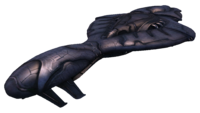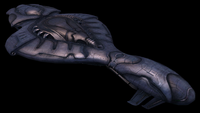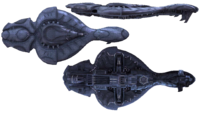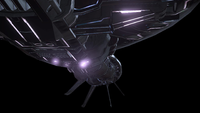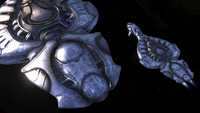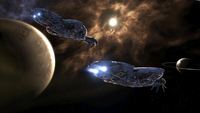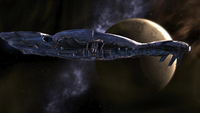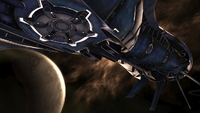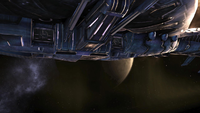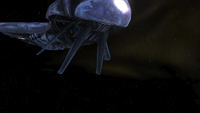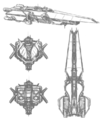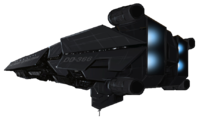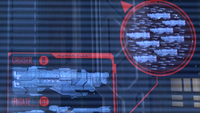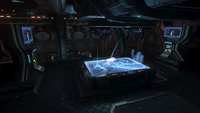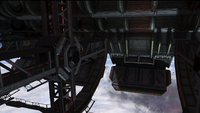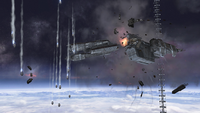Archive:Halo Waypoint/2009 to 2014/Universe/Ships
From Halopedia, the Halo wiki
| The following is a verbatim transcription of an official document for archival reasons. As the original content is transcribed word-for-word, any possible discrepancies and/or errors are included. |
Ships
Battlecruiser
| BATTLECRUISER | |||
|---|---|---|---|
Since the very beginning, the Covenant's primary mode of intergalactic transportation has consistently been the battlecruiser. Unlike the larger assault carriers or the more aggressive destroyers, the battlecruiser serves a role somewhere in between—a fully weaponized warship with the ability to apply meaningful military deployment. This must be central to the reason it is frequently utilized, easily surpassing the numbers of any other known Covenant vessel. Nearly two kilometers from stem to stern, the standard battlecruiser follows the typical architecture of a Covenant ship—a sleek amphibious design with sweeping contours and perfect symmetry. Along its undercarriage are four hangar bays aft of a large circular platform which can be detached and lowered onto a planet's surface. The ship then generates a vertical gravity beam between the ground and the vessel for surface-to-air conveyance of infantry, supplies, and assets. Within the ship, various bays consist of engineering, medical, armory, barracks, and religious facilities, all compartmentalized and interconnected by a network of narrow corridors and lifts. Buried deep within the vessel's heart is the command deck, a large room with a centralized bridge platform typically occupied by only the highest-ranking officers. A considerable amount of intel on Covenant battlecruisers was discovered in September 2552 within a CCS-class ship that was infiltrated and captured by UNSC forces just above an alien ringworld known as Halo. The Master Chief and a handful of Marines assaulted the Truth and Reconciliation as it ferried troops and supplies between the ship and ground, eventually stealing their way inside the vessel and recovering Captain Jacob Keyes, who had been captured by the Covenant. Only months later, the Prophet of Regret would lay siege to Earth with a small fleet composed of two assault carriers and thirteen battlecruisers—the latter of which were eventually tasked with the weighty responsibility of maintaining the Covenant's war effort after the humans had quickly destroyed one of the assault carriers and forced the other to retreat. These battlecruisers kept the UNSC's naval presence occupied in space, while deploying a bevy of expeditionary and reconnaissance forces planetside—a coordinated effort to locate a significant religious artifact. Throughout the war, the Covenant battlecruiser has repeatedly proven to be a stalwart and vital element to their space efforts, having given them a numeric, strategic, and technological advantage. While humanity will likely always associate the battlecruiser with horror and dread, it was ironically the Elite-led Fleet of Retribution, an armada of eight battlecruisers, that ultimately halted the Covenant's swath of devastation and ended the war high above the Forerunner installation known as the Ark.[1]
| |||
Citation:
{{Ref/Site|URL=http://halo.xbox.com/en-us/Universe/detail/battlecruiser/355706b7-6bd3-480a-89b7-6986e8cd03a3|Site=Halo Waypoint|Page=Battlecruiser|D=28|M=04|Y=2012|LocalArchive=Archive:Halo Waypoint/2009 to 2014/Universe/Ships#Battlecruiser}} |
UNSC The Heart of Midlothian
| UNSC THE HEART OF MIDLOTHIAN | |||
|---|---|---|---|
The Heart of Midlothian was a UNSC destroyer which participated in a number of engagements throughout the Covenant War—the final being a fateful journey to the remote colony of Algolis. Approximately 485 meters from stem to stern and weighing in at 7,900 metric tons, the Midlothian hefted a pair of magnetic accelerator cannons, a Shiva-class nuclear payload, and an Archer missile firing array. It was, without a doubt, a ship to be reckoned with. Although UNSC destroyers were historically employed on escort missions or in large-scale fleet engagements, the Midlothian had been sent alone to the planet of Algolis, where a small Covenant contingent had made landfall. Upon arrival, the Midlothian was to slingshot the gravity well of a nearby gas giant, following an asteroidal trajectory toward the planet. After deploying a groundside detachment which included ODSTs, the destroyer was to rendezvous with a frigate in low orbit to assist with evacuation efforts. After evacuating the population and destroying a series of classified prototype weapon systems—preventing Covenant capture of cutting-edge technology—these ships were then to loop out of orbit and escape prior to the arrival of a larger enemy force. The Heart of Midlothian, however, never made it to Algolis. The destroyer was assaulted by a battlegroup of Covenant ships. Shortly after it was forcibly boarded, the ship was destroyed—as required by the Cole Protocol—an act which would prevent information about the location of Earth from falling into enemy hands.[2]
| |||
Citation:
{{Ref/Site|URL=http://halo.xbox.com/en-us/intel/related/gallery/unsc-the-heart-of-midlothian/a0711b9f-4241-4c5b-9e2d-2110775cafa2|Site=Halo Waypoint|Page=UNSC The Heart of Midlothian|D=26|M=09|Y=2011|LocalArchive=Archive:Halo Waypoint/2009 to 2014/Universe/Ships#UNSC The Heart of Midlothian}} |
UNSC Say My Name
| UNSC SAY MY NAME | |||
|---|---|---|---|
As the Covenant forces broke past the orbital defense grid surrounding the Earth's atmosphere, a contingent of UNSC vessels attempted to intercept, engaging as they accelerated toward the planet's surface. During the conflict, a single Covenant assault carrier burrowed into the atmosphere, coming to rest above the city of New Mombasa–demanding the military's immediate and focused attention. Enter UNSC heavy cruiser Say My Name. Equipped with a Magnetic Accelerator Cannon and Archer missile pods, this powerful vessel was not a stranger to military conflicts with the Covenant. Nevertheless, Fleet HQ would issue an order that even the ship's admiral had not anticipated. The UNSC Say My Name was to jettison a number of Orbital Drop Shock Troopers onto the carrier’s outer hull, breaching its armature and gaining access to its interior. Whether their ultimate goal was destroy the ship from inside or to covertly apprehend the Covenant’s Prophet of Regret, all the UNSC's plans would quickly become irrelevant. As the drop took place, the assault carrier tore a hole into subspace directly above the city, escaping to a newly discovered Forerunner installation and ushering in large-scale devastation. The majority of ODST units deployed in this mission perished during the initial Slipspace rupture while still airborne. Of the handful of troopers which survived, five were from a squad consisting largely of replacements, recently confiscated by ONI for use in a classified, groundside operation–and this new mission saved their lives during the drop, leading them away from the carrier's devastation and toward the planet’s surface.[3] | |||
Citation:
{{Ref/Site|URL=http://halo.xbox.com/en-us/intel/related/gallery/unsc-say-my-name/87da73b5-cede-44fd-906e-c3d1f57abf44|Site=Halo Waypoint|Page=UNSC Say My Name|D=24|M=04|Y=2011|LocalArchive=Archive:Halo Waypoint/2009 to 2014/Universe/Ships#UNSC Say My Name}} |
Sources
- ^ Halo Waypoint, Battlecruiser (Retrieved on Apr 28, 2012) [local archive] [external archive]
- ^ Halo Waypoint, UNSC The Heart of Midlothian (Retrieved on Sep 26, 2011) [local archive] [external archive]
- ^ Halo Waypoint, UNSC Say My Name (Retrieved on Apr 24, 2011) [local archive] [external archive]
